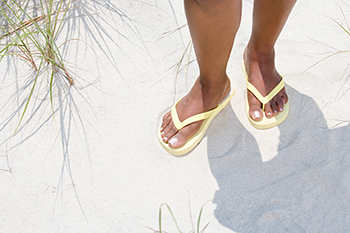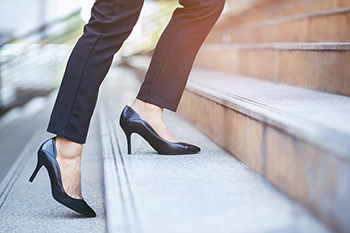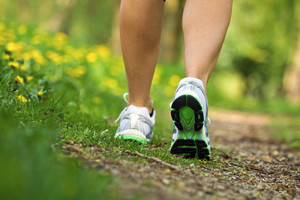Connect With Us
Blog
Items filtered by date: April 2022
Keeping Your Feet in Shape With Exercise

Just as we need to keep our cardiovascular system and our overall body in shape, it is a good idea to exercise the feet. Be careful not to overstretch, not to overdo it in the beginning and to build up the repetitions gradually. Here are a few simple exercises that can help to keep your feet, toes, and ankles in shape. Achilles tendon and plantar fasciitis stretch: Sitting on the floor with a straight back and your legs extended in front of you, loop a towel around the ball of your right foot and pull it toward you. Try to keep your knees straight and hold for 30 seconds. Repeat three times on each leg. Simple plantar fascia stretch: Sit on a straight chair with one foot crossed on top of the opposite knee. Hold the ball of the foot and gently stretch it toward your leg. Hold for 15-20 seconds. Do this 3 times and repeat on the other foot. Ankle range of motion: From a sitting or reclining position, bend your ankle toward your body as far as you can, and then point your foot in the opposite direction, 10 times. Repeat on the opposite foot. If you have any toe, foot, or ankle pain that seems out of the ordinary, it is a good idea to see a podiatrist for a complete exam.
Everyday foot care is very important to prevent infection and other foot ailments. If you need your feet checked, contact Elie C. Daniel, DPM from Illinois. Our doctor can provide the care you need to keep you pain-free and on your feet.
Everyday Foot Care
Often, people take care of their bodies, face and hair more so than they do for their feet. But the feet are a very important aspect of our bodies, and one that we should pay more attention to. Without our feet, we would not be able to perform most daily tasks.
It is best to check your feet regularly to make sure there are no new bruises or cuts that you may not have noticed before. For dry feet, moisturizer can easily be a remedy and can be applied as often as necessary to the affected areas. Wearing shoes that fit well can also help you maintain good foot health, as well as making it easier to walk and do daily activities without the stress or pain of ill-fitting shoes, high heels, or even flip flops. Wearing clean socks with closed shoes is important to ensure that sweat and bacteria do not accumulate within the shoe. Clean socks help to prevent Athlete’s foot, fungi problems, bad odors, and can absorb sweat.
If you have any questions please feel free to contact our offices located in Princeton, Peru, and Mendota, IL . We offer the newest diagnostic and treatment technologies for all your foot and ankle needs.
Will Wearing Flip Flops Damage My Feet?
 People often wear flip-flops in summer and warmer weather. These shoes often feel comfortable, but if worn too much and for long periods of time they can cause foot and body problems. The lack of support in flip-flops can lead to issues with foot arches and heels, including painful plantar fasciitis – an inflammation of the fascia on the bottom of the foot. Long-term pain in foot arches and heels can further lead to bone spurs or impact the way one walks, which can cause further problems with the knees, hips, and the back to develop. If pain in the feet results from wearing such shoes, a visit to a podiatrist is suggested to halt or treat serious issues from developing.
People often wear flip-flops in summer and warmer weather. These shoes often feel comfortable, but if worn too much and for long periods of time they can cause foot and body problems. The lack of support in flip-flops can lead to issues with foot arches and heels, including painful plantar fasciitis – an inflammation of the fascia on the bottom of the foot. Long-term pain in foot arches and heels can further lead to bone spurs or impact the way one walks, which can cause further problems with the knees, hips, and the back to develop. If pain in the feet results from wearing such shoes, a visit to a podiatrist is suggested to halt or treat serious issues from developing.
Flip-flops are not always the best choice of footwear. If you have any concerns about your feet or ankles, contact Elie C. Daniel, DPM from Illinois. Our doctor will assist you with all of your foot and ankle needs.
Flip-Flops and Feet
When the weather starts warming up, people enjoy wearing flip-flops. Flip-flops are comfortable, stylish, and easy to slip on and off; they're perfect for any summer beach goer. However, these shoes can cause harm to the feet.
How Can Flip-Flops Affect Me Long-Term?
- Ankle problems
- Hip problems
- Lower back problems
- Pain in the balls of the feet
- Problems with foot arches
- Changes in the way you walk
Are There Injuries Associated with Flip-Flops?
Yes. Since flip-flops are relatively weak and do not provide the same amount of support as sneakers, people who wear flip-flops regularly are more susceptible to injuries. On top of that, the open nature of the shoe makes your feet more prone to other problems, such as cuts and even infections. Common injuries and ailments include:
- Sprained ankles
- Blisters
- Infections
- Cuts and Scrapes
I like Wearing Flip-Flops. Are There Safe Alternatives?
When buying flip-flops, try to find ones that have sturdy soles and that are made of high-quality materials that will support for your feet. These flip-flops will cost more but will also last longer as a result.
If you have any questions please feel free to contact our offices located in Princeton, Peru, and Mendota, IL . We offer the newest diagnostic and treatment technologies for all your foot and ankle needs.
Let the Expert Treat Your Ingrown Toenails
Stretching the Feet May Help High Heel Wearers
 Recent research has indicated the most common place on the body that is affected by wearing high heels are the feet. Excess pressure is placed on the front of the foot when high heels are worn. When this type of shoe is frequently worn, serious foot conditions may develop. Some of these can include bunions, hammertoes, and Morton’s neuroma. Many people who enjoy wearing high heels understand the benefits of properly stretching the Achilles tendon at the end of the day. This can be done by standing on a step, and gently stretching the heel downward. Additionally, rotating the ankle in circles can help to strengthen the entire foot. If you have questions about wearing high heels, and how they can affect your feet, please speak with a podiatrist.
Recent research has indicated the most common place on the body that is affected by wearing high heels are the feet. Excess pressure is placed on the front of the foot when high heels are worn. When this type of shoe is frequently worn, serious foot conditions may develop. Some of these can include bunions, hammertoes, and Morton’s neuroma. Many people who enjoy wearing high heels understand the benefits of properly stretching the Achilles tendon at the end of the day. This can be done by standing on a step, and gently stretching the heel downward. Additionally, rotating the ankle in circles can help to strengthen the entire foot. If you have questions about wearing high heels, and how they can affect your feet, please speak with a podiatrist.
High heels have a history of causing foot and ankle problems. If you have any concerns about your feet or ankles, contact Elie C. Daniel, DPM from Illinois. Our doctor can provide the care you need to keep you pain-free and on your feet.
Effects of High Heels on the Feet
High heels are popular shoes among women because of their many styles and societal appeal. Despite this, high heels can still cause many health problems if worn too frequently.
Which Parts of My Body Will Be Affected by High Heels?
- Ankle Joints
- Achilles Tendon – May shorten and stiffen with prolonged wear
- Balls of the Feet
- Knees – Heels cause the knees to bend constantly, creating stress on them
- Back – They decrease the spine’s ability to absorb shock, which may lead to back pain. The vertebrae of the lower back may compress.
What Kinds of Foot Problems Can Develop from Wearing High Heels?
- Corns
- Calluses
- Hammertoe
- Bunions
- Morton’s Neuroma
- Plantar Fasciitis
How Can I Still Wear High Heels and Maintain Foot Health?
If you want to wear high heeled shoes, make sure that you are not wearing them every day, as this will help prevent long term physical problems. Try wearing thicker heels as opposed to stilettos to distribute weight more evenly across the feet. Always make sure you are wearing the proper shoes for the right occasion, such as sneakers for exercising. If you walk to work, try carrying your heels with you and changing into them once you arrive at work. Adding inserts to your heels can help cushion your feet and absorb shock. Full foot inserts or metatarsal pads are available.
If you have any questions please feel free to contact our offices located in Princeton, Peru, and Mendota, IL . We offer the newest diagnostic and treatment technologies for all your foot and ankle needs.
What Kind of Shoes Should I Get if I Am a Fitness Walker?
 With the preponderance of different types of athletic shoes, it can be hard to know which type of shoe is best for you and your needs. Walking shoes are generally designed for comfort rather than performance. They tend to be stiffer and more cushioned than running shoes. Running shoe designers strive to provide the necessary structure and cushioning with the least amount of weight and seaming that might cause blisters. Fitness walkers should look for shoes that are light, have enough cushioning, do not have a great difference between the heel and toe height, have an undercut rather than a flared heel, and that is flexible or bend easily at the forefoot. Running stores that provide expertise in fitting shoes can help with choosing specific brands that might work best for you. However, visiting a podiatrist for shoe recommendations based on your individual needs at various stages of life is recommended for the long-term health and comfort of your feet.
With the preponderance of different types of athletic shoes, it can be hard to know which type of shoe is best for you and your needs. Walking shoes are generally designed for comfort rather than performance. They tend to be stiffer and more cushioned than running shoes. Running shoe designers strive to provide the necessary structure and cushioning with the least amount of weight and seaming that might cause blisters. Fitness walkers should look for shoes that are light, have enough cushioning, do not have a great difference between the heel and toe height, have an undercut rather than a flared heel, and that is flexible or bend easily at the forefoot. Running stores that provide expertise in fitting shoes can help with choosing specific brands that might work best for you. However, visiting a podiatrist for shoe recommendations based on your individual needs at various stages of life is recommended for the long-term health and comfort of your feet.
For more information about walking shoes versus running shoes, consult with Elie C. Daniel, DPM from Illinois. Our doctor can measure your feet to determine what your needs are and help you find an appropriate pair of footwear.
Foot Health: The Differences between Walking & Running Shoes
There are great ways to stay in shape: running and walking are two great exercises to a healthy lifestyle. It is important to know that running shoes and walking shoes are not interchangeable. There is a key difference on how the feet hit the ground when someone is running or walking. This is why one should be aware that a shoe is designed differently for each activity.
You may be asking yourself what the real differences are between walking and running shoes and the answers may shock you.
Differences
Walking doesn’t involve as much stress or impact on the feet as running does. However, this doesn’t mean that you should be any less prepared. When you’re walking, you land on your heels and have your foot roll forward. This rolling motion requires additional support to the feet.
Flexibility – Walking shoes are designed to have soft, flexible soles. This allows the walker to push off easily with each step.
If you have any questions, please feel free to contact our offices located in Princeton, Peru, and Mendota, IL . We offer the newest diagnostic and treatment technologies for all your foot care needs.

